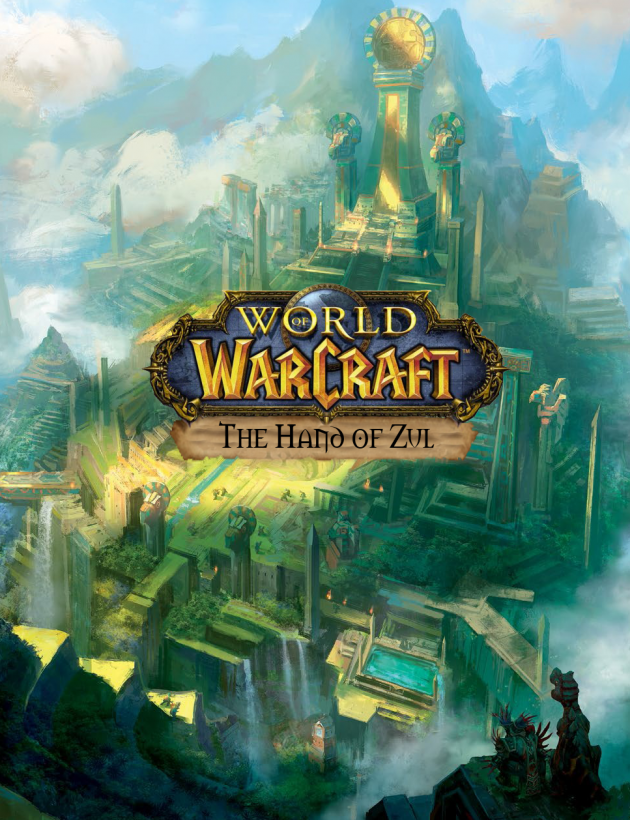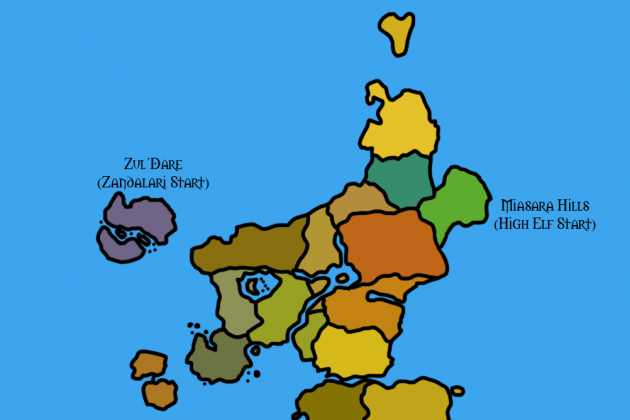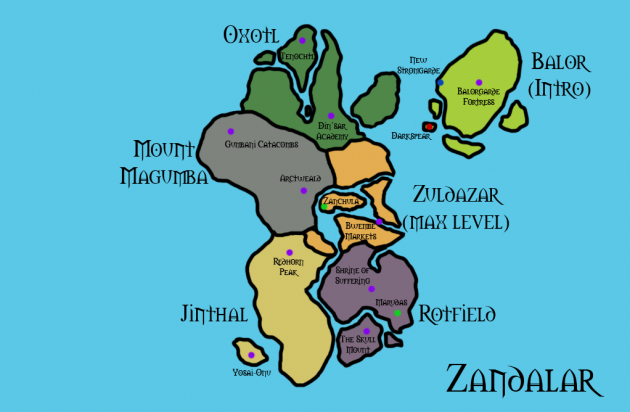Welcome to the next portion of my The Hand of Zul expansion concept! In this post I’ll be providing details on the zones I’ve created for Zandalar and the high elf and Zandalari troll starting areas.
 The continent of Zandalar is comprised of six zones, with all players starting their journey to the level cap in Balor and ending at Zuldazar. The four other zones, Oxotl, Mount Magumba, Jinthal, and Rotfield, can be completed in any order via level scaling. Two new zones have also been added to the Eastern Kingdoms, Zul’Dare and Miasara Hills. Instanced versions of these zones are the starting locations for Zandalari trolls and high elves, respectively. Uninstanced versions of these areas serve as max-level world quest sites.
The continent of Zandalar is comprised of six zones, with all players starting their journey to the level cap in Balor and ending at Zuldazar. The four other zones, Oxotl, Mount Magumba, Jinthal, and Rotfield, can be completed in any order via level scaling. Two new zones have also been added to the Eastern Kingdoms, Zul’Dare and Miasara Hills. Instanced versions of these zones are the starting locations for Zandalari trolls and high elves, respectively. Uninstanced versions of these areas serve as max-level world quest sites.
Zul’Dare: Covered in ruins from a troll tribe lost to the ravages of time, Zul’Dare serves as a mournful reminder of what the troll empire once was. Zul has sent the Golden Fleet here to turn Zul’Dare into a staging ground for the Zandalari’s invasion of the Eastern Kingdoms. However some of the Zandalari trolls stationed here have begun to question the morality of Zul’s actions. A group of Horde champions sent to protect the Undercity might serve as the final push these worried trolls need to stand up against Zul.
Notes: I’ve made a retcon to Zul’Dare’s position, having it west of Tirisfal Glades rather than south of Gilneas. As the same positional change was done to Tol Barad (originally directly south of Hillsbrad Foothills) in Cataclysm, I felt that if Blizzard can change where an island is located then so can I. This allows the island to big enough to serve as a starting zone and put it closer to the Undercity to facilitate the Zandalari rebels joining the Horde. In terms of aesthetic, Zul’Dare resembles a warmer Zul’Drak, covered in large, mostly intact ruins and withered plantlife. Its meant to feel like a graveyard for and reminder of what the troll civilization once was, and could be again if Zul succeeds.
The Starting Zones
Miasara Hills: No longer feeling welcome in Dalaran, the high elves of the Silver Covenant have decided to seek out a new homeland for what remains of their people. Selecting the forests the forests east of the Ghostlands, the Silver Covenant plans to wipe out the remaining Amani presence and claim the area for their own. What they find instead is that the Zandalari have already arrived, rallying the Amani to their cause and seeking to claim an ancient treasure within the shrine of the Amani serpent loa, Ula’tek.
Notes: The Amani were underutilized in The Burning Crusade in my opinion, and we’ve seen from the Zul’Aman instance that there’s far more of their land waiting to be explored. This zone also brings in concepts from the old World of Warcraft RPG, such as the Shrine of Ula’tek and its namesake loa. While not canon, Blizzard frequently takes ideas from the RPG and adds them back into WoW (see: almost everything in Northrend). Miasara Hills resembles a graphically updated Zul’Aman, giving us more of an insight into what Quel’Thalas looked like prior to the arrival of the Highborne. It also features a new architectural style for the high elves, to help further distinguish them from their sin’dorei counterparts.
The Continent of Zandalar
Balor: For centuries, Balor served as a military buffer between Zandalar and the human kingdoms. Following a massive attack by the Horde in the First War, the island fell into disrepair. Balor would serve as an excellent staging ground for the Alliance and Horde in the war against Zul, but the island has already been occupied. Gnolls, troggs, kodolds and various mercenaries loyal to the Zandalari have captured the island. At its center, the old Balorgarde Fortress serves as the mongrel army’s stronghold, and lair of the gigantic gnoll warlord Gangris Riverpaw.
–New Stromgarde: Named in honor of the kingdom which lead humanity to victory in the Troll Wars, New Stromgarde represents both the Alliance’s base of operations against the Zandalari, and the fulfillment of Danath Trollbane’s promise to see his kingdom restored.
–Darkspear: Formerly the Zandalari garrison Mul’towa the Horde has captured the area and fortified it into the city of Darkspear, their foothold on Zandalar.
Notes: As with Zul’Dare, I’ve fudged Balor’s location a bit. Then again, also like Zul’Dare, there no lore about the area other than that it exists and the Horde wiped out the humans there during the First War. As the intro zone all players first go through, the initial questline in Balor is shorter than the other zones’. Much of the zone is used for max-level content and the site of the capital cities. To help avoid troll-fatigue, this zone focuses mainly on the “mongrel races” serving Zul. Gnolls make up the primary force, as I believe they could be serious, interesting enemies given updated models and being treated less like canon fodder. Just look at this concept art for “Mongrel Horde” gnolls, for example. Balor’s sole instance is the five-man dungeon Balorgarde Fortress.
Oxotl: The jungles of Oxotl are home to the largest dinosaurs in all of Azeroth. Even the Zandalari are weary of the deep jungle, staying near the forest’s edge where they train in the arts of dinomancy at the prestigious Din’Sar Academy. Explorers who venture into the jungle itself and survive the dinosaurs will have to contend with the raptaak, a race of raptor-men whose obsession with blood magic requires a near constant steam of sacrificial victims. The salamander-like xotli serve as the raptaak’s primary source for blood, and may prove valuable allies against the Zandalari.
Notes: Aesthetically, Oxotl is based around the rain-forests of Central and South America, and the ancient Aztec and Mayan civilizations. The zone is divided into two distinct regions, the jungle and the area directly north of Zuldazar. The jungle has minimal troll presence, with dinosaurs, raptaak, and xotli instead. The much smaller “forest’s edge” region has a Zandalari presence. Oxotl is another way to ensure there is no overload of trolls, as the amount of troll content has been an issue with players long before the talks of “orc-fatigue.” Oxotl has two five-man dungeons, the raptaak capital Tenochtl and Din’Sar Academy.
Mount Magumba: Home to ancient monasteries, catacombs, and temples, the peaks of Mount Magumba are among the most sacred places in Zandalar. The Gumbani tribe, a caste of “mountain trolls,” are the keepers of the mountain, where they perform religious rites and inter the bodies of troll-kind’s greatest heroes in the Gumbani Catacombs. In the southeastern lowlands, mountain troll farmers are menaced by the goat-eating chupen and a relic population of jalgar, the savage ancestors of furbolgs. Zul has ordered the Gumbani to begin raising the troll corpses here into undeath to serve the Zandalari once again, reports even suggest that Zul’jin himself is among the mummified trolls returned to life…
Notes: Mount Magumba is based around the Andes mountain range and Machu Picchu. Unlike the previous two zones, this is full of trolls, their largest presence outside of Zuldazar itself. Aside from trolls, jalgar and chupen, Mount Magumba is home to several new beasts to encounter, such as alpacas and giant anteaters, both of which are mounts. Mount Magumba has two five man dungeons, Gumbani Catacombs and the jalgar-infested forest known as the Arctweald.
Jinthal: A remote corner of Zandalar, covered by expansive grasslands or “pampas.” Long-necked titanosaurs graze on the open fields while two races maintain an uneasy peace. The southern tip of Jinthal was once home to a mogu embassy, but after they were cut off from Pandaria by the Sundering, these mogu have changed over the last ten-thousand years into a new race calling themselves onu. In the north, a race of wildebeest-tauren referred to as tenyol struggle for survival against bands of centaur and quillboar. While the onu have always been loyal to the Zandalari, the tenyol have remained independent. But now they are being courted into an alliance with Zul by one of his new allies, Magatha Grimtotem.
Notes: A mixture of grassland and desert, Jinthal has a diverse group of influences. The zone itself is inspired by the South American pampas, while the tenyol have both the standard tauren Native American influence and borrow from African cultures as well. The onu are based on the oni from Japanese folklore and draw stylistic influence from feudal Japan as well. Much of the zone’s storyline revolves around assisting Baine Bloodhoof in preventing the tenyol from allying with Magatha, with a side story focused on defeating the onu. Jinthal has two five man dungeons, the tenyol capital Redhorn Peak, and the onu capital Yosai Onu.
Rotfield: For millennia, the bodies of the Zandalari’s sacrifices have been disposed of here. The result of this practice is Rotfield, an expanse of skeletons that stretches as far as the eye can see. Zandalar’s native centaur clans find the desolate landscape just to their liking, and make their homes in tunnels and structures carved from the piles of bones. Yet there is a secret history to Rotfield, one that only the highest echelons of the Zandalari priesthood knows. An ancient evil once slumbered beneath this land, and its influence remains…
Notes: Rotfield is the most “out there” type zone in The Hand of Zul. It’s just a literal field of piles upon piles of skeletons. This turns out to be where the high centaur from World of Warcraft: Bloodsworn originate from, with the Garad’kra themselves enlisting Horde players to help them take revenge on their not-quite-dead nemesis, High Khan Aratas. Alliance players assist the Explorer’s League instead, who seek to discover the origins of the high centaur (and also defeat Aratas). Rotfield contains three instances, the five-man dungeons Shrine of Suffering and The Skull Mount, and the raid instance Marudas.
Zuldazar: The city of Zuldazar is both the jewel of the Zandalari empire and their rallying symbol for the war against the Horde and Alliance. All but destroyed by the Cataclysm, Zuldazar lays in ruin. The upper tiers of the city are mostly intact, but the lower sections and markets are plagued by sinkholes and flooding. Now that Zandalar’s destruction has been halted by Magatha, the Zandalari have set to work reclaiming the lost portions of the city. Meanwhile at Zanchula palace, King Rastakhan sits atop his golden throne, awaiting the “heroes” of Azeroth to challenge him, and learn the wrath of a God-King.
Notes: This is the Suramar/Vale of Eternal Blossoms of The Hand of Zul. Zuldazar is focused entirely around max-level content. The city proper is where players will see the true might of the Zandalari army up close and personal, while the flooded regions are populated by various other races that have made a home in the ruins, such as naga, chupen, xotli, and more of Zul’s mongrel army. Zuldazar contains two instances, the five-man dungeon Bwembe Markets, and the Zanchula Palace raid.
In the next installment, we’ll focus on the bestiary for The Hand of Zul, going into more depth on the many creatures and races that call Zandalar home.











Nice idea, especially love how you included Balor!
I don’t know if you’ve already done this in a different expansion concept, but I think Isiden Perenolde could be quite an interesting character if he had a lot more character development. Maybe you could put him in an expansion concept? Just my suggestion.
Keep up the good work!